 |
Lucy Medium Swan Neck Bracket
Genre: Swan neck bracket
The "swan neck" bracket probably gained prominence as the electric arc lamp became popular in the late
19th century. The arc lamp required suspending above the roadway by its canopy, so a sweeping, curved
bracket was utilised to position the lantern relative to the column. With the advent of the inverted mantle,
gas manufacturers followed suit; suspending lanterns by their canopies prevented shadows
and the dark spaces associated with the early post-top Windsor style frame lanterns.
Finally, the first lanterns for tungsten filament bulbs followed the trend and were also top-entry.
The swan neck was easy to manufacture from a iron or steel rolled tube. They were either fully formed to
support the lantern directly, or finished on the horizontal so a decorative finial was required.
Other decorations included the purely aesthetic scrollwork and collars, whilst tulip and leaf husks
not only beautified the spigot cap, but also provided additional protection from rust at the
joint between the bracket and spigot.
The swan neck was a popular choice for a "gas conversion" in the 1940s and 1950s where the original gas
post-top lantern was removed and replaced with a swan neck and high level termination. As columns were
originally made in various heights, swan neck brackets were also made in different sizes so the lantern
height above the road could be standardised.
By the 1950s, the swan neck bracket was still extremely popular, as manufacturers were still producing large
numbers of top-entry lanterns. However, the lines became simpler, and the decoration was eventually scaled
down and finally removed entirely. It was a practical move: scrollwork and spigot joints formed dirt
and moisture traps where corrosion could set in.
As side entry lanterns became popular, the swan neck declined in numbers. Brackets evolved into simple
bracket arms, or became part of the column (as with the popular "hockey stick" column). However, the swan
neck does live on, albeit in smaller numbers, and is still available as a "traditional" option for
decorative and/or heritage style street lighting.

Name: Lucy Medium Swan Neck Bracket
Date: Circa 1930s - 1960s
Dimensions: TBA (height), TBA (width)
Specs: Flower finial, single scrollwork, simple collar, Lucy time switch box with spigot
Lantern: ESLA Bi-Multi Group "A" Two-Way 165° 7½°
History
The history of Lucy columns and brackets isn't documented and no catalogues have surfaced.
The finial and scrollwork decoration are typical of Lucy which is how this bracket was identified. The time switch
box came from a different source, has a Lucy logo and fits perfectly which further suggests the bracket's provenance.
As a medium sized bracket, it was intended as an electrical conversion bracket for a fairly tall gas column.
Popularity
These medium sized brackets appeared to be quite common throughout the UK.
The Lucy Bracket In My Collection

|
|
facing profile
This bracket (and ESLA
Bi-Multi lantern) were found in a reclaim yard in North London. The bracket
was in fairly poor condition with a rust hole and missing time switch/fuse box cover. (The state of the remaining studs suggested
the wing nuts had seized and the nuts were simply smashed off along with the cover). However, I'd been after a small Group "A"
Bi-Multi for some time, so purchased the bracket and lantern.
|
|

|
|
front profile
Whilst the lantern was in fairly good condition, the bracket required stripping and filling; new studs were installed
to replace the old bent and smashed ones.
|
|

|
|
trailing profile
The lantern originally had a very old time switch in it, one of the earliest I've ever seen.
I'm not a big times witch collector so I gave it to fellow collector Phil.
|
|

|
|
finial
The flower on the finial is typical Lucy along with the top point. The small pointed stud (the continuation
of the swan neck itself) is normally found on the finials of small or medium sized brackets: Lucy seemed to
save the curled points for the finials of the largest brackets.
|
|

|
|
scrollwork
The scrollwork was welded to the bracket instead of being held with clamps.
Water had collected here and rusted through the metalwork of the bracket which required some filling.
|
|

|
|
base of bracket
The base of the swan neck simply screwed into the top of the time switch/fuse box. There was no decorative joint, or
tapering of the casting to allow water to flow away. Whilst this bracket was in good condition, this was usually the
area where severe corrosion occurs.
|
|

|
|
time switch box: road side
Strangely the road side of the time switch/fuse box was entirely blank with no elaboration, decoration or maker's
mark.
|
|

|
|
time switch box: pavement side
Amazingly when I took the bracket to Phil's so he could remove the time switch base,
he actually had the correct Lucy box cover in his van. So an original
Lucy 7504 cover has been fitted back on the time switch/fuse box.
Additionally new threaded studs and wing nuts were fitted.
|
|

|
|
time switch box: interior
I fitted a Horstmann time switch and two porcelean fuses, therefore restoring the
bracket and its internal wiring back to its 1960s condition.
I was very pleased to aquire this bracket and lantern; it's the spitting image of those which used to be installed by
the London Borough Of Merton. In fact, after tipping off P. about some remaining examples,
I was pleased to see from his photographs that this lantern and bracket is almost exactly the same.
(The only minor difference is the clamps holding on the scrollwork and the position of the scrollwork
which I consider minor). For a comparison, see below.
Whilst it'll never be known where this bracket originally stood, I've decided to restore it using Merton's original
colour scheme.
|
|
Lucy Medium Bracket As Purchased
This bracket and lantern featured on my original site as part of a restoration series. These are the only pictures I took:
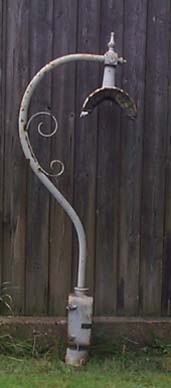 The bracket and lantern as purchased. Not in the best of conditions.
The bracket and lantern as purchased. Not in the best of conditions.
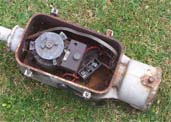 The original contents of the gear box.
The original contents of the gear box.
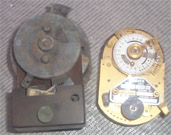 A comparision of the Venner inside the gear box with a 1960s version. The old timeswitch was
swapped with Phil.
A comparision of the Venner inside the gear box with a 1960s version. The old timeswitch was
swapped with Phil.
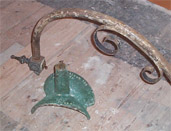 After stripping the bracket and lantern, it was beheaded. Notice the original ESLA green still
underneath.
After stripping the bracket and lantern, it was beheaded. Notice the original ESLA green still
underneath.
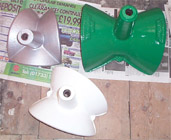 The ESLA was restored with two others- this gives a good indication of the various shapes and
sizes.
The ESLA was restored with two others- this gives a good indication of the various shapes and
sizes.
|
|



